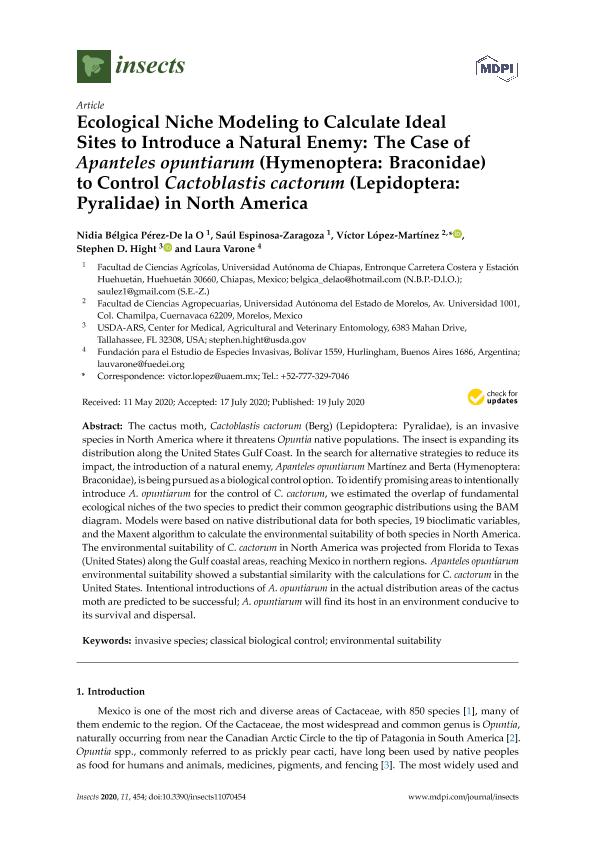Mostrar el registro sencillo del ítem
dc.contributor.author
Pérez De la O, Nidia Bélgica
dc.contributor.author
Espinosa Zaragoza, Saúl
dc.contributor.author
López Martínez, Víctor
dc.contributor.author
Hight, Stephen D.
dc.contributor.author
Varone, Laura

dc.date.available
2022-09-21T15:34:42Z
dc.date.issued
2020-07
dc.identifier.citation
Pérez De la O, Nidia Bélgica; Espinosa Zaragoza, Saúl; López Martínez, Víctor; Hight, Stephen D.; Varone, Laura; Ecological niche modeling to calculate ideal sites to introduce a natural enemy: the case of apanteles opuntiarum (hymenoptera: Braconidae) to control cactoblastis cactorum (lepidoptera: Pyralidae) in North America; Multidisciplinary Digital Publishing Institute; Insects; 11; 7; 7-2020; 1-14
dc.identifier.uri
http://hdl.handle.net/11336/169756
dc.description.abstract
The cactus moth, Cactoblastis cactorum (Berg) (Lepidoptera: Pyralidae), is an invasive species in North America where it threatens Opuntia native populations. The insect is expanding its distribution along the United States Gulf Coast. In the search for alternative strategies to reduce its impact, the introduction of a natural enemy, Apanteles opuntiarum Martínez and Berta (Hymenoptera: Braconidae), is being pursued as a biological control option. To identify promising areas to intentionally introduce A. opuntiarum for the control of C. cactorum, we estimated the overlap of fundamental ecological niches of the two species to predict their common geographic distributions using the BAM diagram. Models were based on native distributional data for both species, 19 bioclimatic variables, and the Maxent algorithm to calculate the environmental suitability of both species in North America. The environmental suitability of C. cactorum in North America was projected from Florida to Texas (United States) along the Gulf coastal areas, reaching Mexico in northern regions. Apanteles opuntiarum environmental suitability showed a substantial similarity with the calculations for C. cactorum in the United States. Intentional introductions of A. opuntiarum in the actual distribution areas of the cactus moth are predicted to be successful; A. opuntiarum will find its host in an environment conducive to its survival and dispersal.
dc.format
application/pdf
dc.language.iso
eng
dc.publisher
Multidisciplinary Digital Publishing Institute
dc.rights
info:eu-repo/semantics/openAccess
dc.rights.uri
https://creativecommons.org/licenses/by/2.5/ar/
dc.subject
CLASSICAL BIOLOGICAL CONTROL
dc.subject
ENVIRONMENTAL SUITABILITY
dc.subject
INVASIVE SPECIES
dc.subject.classification
Otras Ciencias Biológicas

dc.subject.classification
Ciencias Biológicas

dc.subject.classification
CIENCIAS NATURALES Y EXACTAS

dc.title
Ecological niche modeling to calculate ideal sites to introduce a natural enemy: the case of apanteles opuntiarum (hymenoptera: Braconidae) to control cactoblastis cactorum (lepidoptera: Pyralidae) in North America
dc.type
info:eu-repo/semantics/article
dc.type
info:ar-repo/semantics/artículo
dc.type
info:eu-repo/semantics/publishedVersion
dc.date.updated
2022-09-19T20:39:55Z
dc.identifier.eissn
2075-4450
dc.journal.volume
11
dc.journal.number
7
dc.journal.pagination
1-14
dc.journal.pais
Suiza

dc.journal.ciudad
Basilea
dc.description.fil
Fil: Pérez De la O, Nidia Bélgica. Universidad Autónoma de Chiapas. Facultad de Ciencias Agrícolas; México
dc.description.fil
Fil: Espinosa Zaragoza, Saúl. Universidad Autónoma de Chiapas. Facultad de Ciencias Agrícolas; México
dc.description.fil
Fil: López Martínez, Víctor. Universidad Autónoma del Estado de Morelos; México
dc.description.fil
Fil: Hight, Stephen D.. US Department of Agriculture. Agricultural Research Service; Estados Unidos
dc.description.fil
Fil: Varone, Laura. Consejo Nacional de Investigaciones Científicas y Técnicas; Argentina. Fundación para el Estudio de Especies Invasivas; Argentina
dc.journal.title
Insects
dc.relation.alternativeid
info:eu-repo/semantics/altIdentifier/url/https://www.mdpi.com/2075-4450/11/7/454
dc.relation.alternativeid
info:eu-repo/semantics/altIdentifier/doi/http://dx.doi.org/10.3390/insects11070454
Archivos asociados
